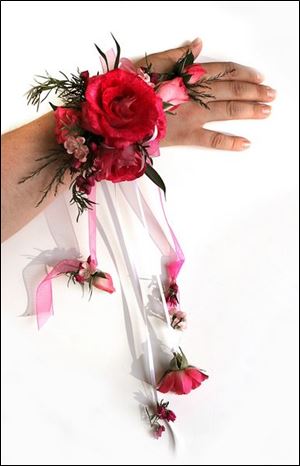
Corsage know-how
4/10/2005
One of the corsages made by Keith Brooks and the Flower Market.
Fresh flowers add a touch of charm to what is, for most young people, their first night of elegance.
But who's supposed to afix the boutonniere and corsage? And how do you know what to get?
A week or so before the dance, the girl should let her date know the color of her gown so he can tell the florist when ordering the corsage. She should tell him whether she wants a wrist or shoulder corsage.
Some students order both corsage and boutonniere in their school colors.
Considering the popularity of low-cut dresses with spaghetti straps, corsages worn on the wrist are more common than those for the shoulder.
Wrist bracelets, a band of flowers tied to the wrist with ribbons that can dangle gracefully, are a new trend, said Sylvania florist Keith Brooks. Corsages, especially on the wrist, take a lot of abuse, so durable flowers are generally used, he said. Fragile freesia is an exception, because of its fragrance.
A nosegay, a small bouquet that is carried, is a less frequently used option.
If she's wearing a black dress, roses can be tipped with black and baby's breath can be sprayed black, said Penny Reneau, co-manager of the Flower Market on Monroe Street.
For a charming presentation to your date, ask the florist to place the corsage in a box and tie it with a ribbon.
Expect to pay $10 to $30 for a corsage, depending on florist and type of flowers used.
A boutonniere for the guy is often a rose with a sprig of ivy or eucalyptus. The stem can be wrapped with ribbon to match the lady's dress. Price ranges from $5 to $10.
The boy should help the girl slip the corsage on her wrist or pin it to her dress. She should pin the boutonniere on his lapel with the enclosed hatpin. Practice before. However, if either is uncomfortable pinning on the flowers, enlist the aid of an adult in the home.